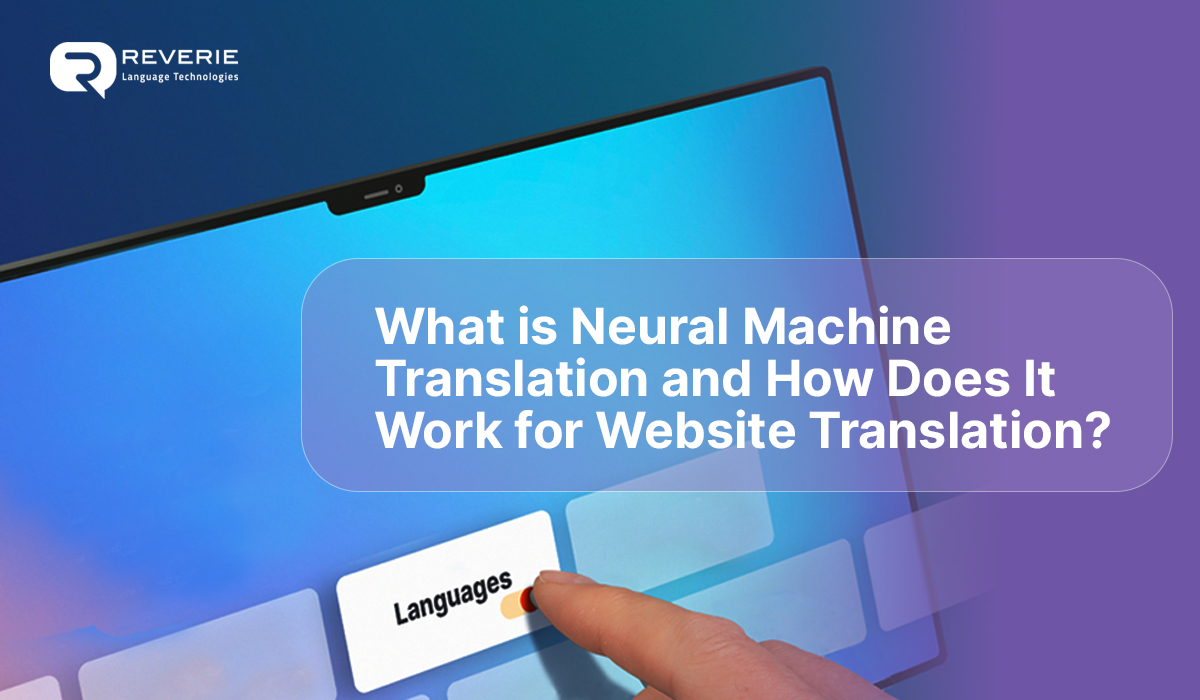An Indian fintech startup wants to expand its digital services across the country. The platform is available in English, but millions of potential users prefer Hindi, Tamil, Bengali, or Marathi. To attract them, the company translates its website using traditional machine translation (MT)—only to find banking terms misinterpreted, grammar errors, and inconsistent messaging.
This results in literal and confusing product descriptions, leading to frustrated customers and ultimately drop in conversions.
Traditional machine translation methods struggle with accuracy, fluency, and contextual understanding. Neural Machine Translation (NMT), powered by AI and deep learning, is now redefining website localisation. It translates entire sentences contextually, ensuring better accuracy, natural fluency, and improved multilingual SEO.
As businesses grow across diverse linguistic markets, adopting NMT-driven website translation can significantly enhance accuracy, engagement, and user experience. Here is everything about NMT and why it’s the future of website localisation.
The NMT Revolution: A Business-First Approach to Website Translation
Expanding into international markets requires accurate, scalable, and cost-effective website translation. Poor translations confuse users, weaken brand trust, and hurt conversions. NMT eliminates these issues by providing AI-powered, context-aware translations that improve over time.
What is Neural Machine Translation?
Neural Machine Translation or NMT is an AI-driven translation technology that processes entire sentences instead of translating word-for-word. It uses deep learning algorithms and neural networks to analyse text structure, predict sentence flow, and enhance linguistic accuracy.
Translation Method | Feature | Limitation |
Rule-Based MT (RBMT) | Uses predefined linguistic rules to translate text. | Struggles with complex sentence structures and lacks adaptability. |
Statistical MT (SMT) | Translates based on probability models from bilingual datasets. | Ignores context, leading to literal and awkward translations. |
Neural MT (NMT) | Uses AI and deep learning to understand sentence flow and context. | Requires high computational power but delivers superior accuracy. |
How Neural Machine Translation Works: The AI Behind Website Translation
Traditional translation methods relied on rule-based systems that followed strict grammar rules or statistical models that predicted translations based on probability. While useful, these methods often failed in contextual accuracy, sentence flow, and cultural nuances. NMT changes this entirely by mimicking human-like translation capabilities through advanced neural networks.
Here’s how NMT interprets and translates language:
Neural Networks Understand Context
- NMT analyses entire sentences, not just individual words. Unlike phrase-based models that translate word by word, NMT considers sentence structure, grammar, and meaning holistically.
- This ensures fluent and natural translations rather than mechanical, literal ones.
Encoding and Decoding Language
- Neural machine translation architecture first encodes the input language, breaking it down into meaningful representations.
- The architecture then decodes it into the target language, restructuring it logically and grammatically.
Transformer Models for Higher Accuracy
- Modern NMT systems use transformer-based AI models, which analyze entire sentences simultaneously using self-attention mechanisms.
- This allows them to prioritize key words and maintain contextual accuracy for more precise translations.
Training with Large Data Sets
- NMT systems process millions of multilingual datasets to recognise patterns, sentence structures, and industry-specific terminology.
- This extensive training enables better adaptation to specialised content, whether for legal, technical, or e-commerce translations.
Why Businesses Are Turning to NMT for Website Localisation
Businesses need instant translations for evolving content, product updates, and customer reviews. Translation APIs ensure real-time localisation without disrupting website operations.
- SEO-Optimised Translations for Global Visibility NMT enhances multilingual SEO by understanding regional search terms, keywords, and metadata, ensuring better search rankings in global markets.
- Personalisation & Regional Adaptation Unlike generic translation tools, NMT adapts to industry-specific terminology, ensuring accurate legal, medical, or technical translations.
- Integration with AI Chatbots & Voice Assistants Businesses use NMT-powered AI chatbots to offer multilingual customer support, enhancing user experience and engagement.
- Cross-Device & Multimodal Adaptability NMT is now being integrated into voice-to-text systems, mobile apps, and IoT interfaces for a fully immersive multilingual digital experience.
Fixing Broken Translations with AI Powered NMT
NMT eliminates inaccurate, inconsistent, and poorly optimised website translations that hurt user experience and SEO. Below is a tabular breakdown of common challenges and how NMT provides accurate, context-aware solutions.
Translation Challenge | Issues It Causes | How NMT Fixes It |
Inconsistent Brand Messaging | Variations in tone and terminology | Ensures uniform translations with AI-driven memory |
Literal Translations | Awkward, unclear messaging | Context-aware AI for natural fluency |
Slow Content Updates | Delays in translating dynamic content | Real-time API-powered translations |
Industry-Specific Terms | Fails to understand technical, legal, or medical terminology, leading to errors | Custom-trained models for domain accuracy |
Cultural Irrelevance | Content feels unnatural to local audiences | Adapts to regional dialects and preferences |
High Translation Costs | Expensive and time-consuming manual updates | Automates at scale, reducing costs |
How Reverie’s AI-Powered NMT Solutions Transform Website Translation
Expanding into diverse linguistic markets requires advanced localisation tools. Reverie’s AI-powered NMT solutions address these challenges with advanced localisation technology, without compromising quality or efficiency.
- Reverie’s Translation API for Instant Localisation
- Integrates with CMS platforms to provide dynamic, context-aware translations.
- Supports business applications, including e-commerce, customer service, and marketing content.
Why Businesses Choose Reverie’s AI-Powered NMT Solutions
- Custom-trained AI models for industry-specific website localisation.
- Integration-friendly APIs for dynamic and real-time translation needs.
- Scalable, cost-effective solutions for businesses entering new markets.
The Smart Choice for Website Translation with NMT
Poorly translated websites drive users away, damage credibility, and limit global reach. Businesses prioritising seamless localisation must integrate AI-powered NMT into their website translation strategy.
NMT ensures faster, more accurate, and cost-effective translations while enhancing SEO and multilingual user engagement. Unlike traditional methods, NMT understands sentence flow, adapts to industries, and delivers brand-consistent translations.
Businesses adopting NMT-driven localisation can seamlessly expand into multilingual markets while maintaining content accuracy and brand voice. Book a free demo today and experience how Reverie’s NMT solutions can transform your website translation strategy.
Faqs
How does NMT improve website translation compared to traditional methods?
NMT uses deep learning to analyse entire sentences, ensuring contextual accuracy, natural fluency, and brand consistency. Unlike rule-based or statistical MT, it adapts to industry-specific terminology and multilingual SEO requirements.
Can Reverie’s NMT handle real-time website translation for dynamic content?
Yes. Reverie’s NMT integrates with APIs to automate translations instantly, keeping product updates, user-generated content, and website changes localised without manual intervention.
Is Reverie’s NMT suitable for industry-specific content?
Yes. Reverie’s NMT can be custom-trained on domain-specific data, ensuring precise, and regulation-compliant translations.
Why should businesses choose Reverie’s AI-powered NMT for website localisation?
Reverie’s NMT provides accurate, scalable, and cost-efficient website translation. It ensures seamless integration, real-time updates, and culturally adaptive localisation for businesses expanding into multilingual markets.
Can Reverie’s NMT be integrated with existing CMS and business platforms?
Yes. Reverie’s NMT seamlessly integrates with CMS platforms, e-commerce systems, and enterprise applications.


